Metal roofs can last a long time, but eventually you will need to look into metal roof restoration in order to maintain or perform repairs when necessary. While there are some cases where you can perform the job yourself, sometimes the task will require a professional. When choosing whether or not to perform the procedure on your own, there are a few things that you need to ask yourself.
In some instances a simple restorative coating can be used, which can be relatively cheap and less time consuming than more labor-intensive repairs. Unfortunately, some roofs cannot be fixed with restoration coatings. In order to figure out the best way to approach your metal roof restoration, it is important that you look at a few variables.
An important initial step in metal roof restoration is figuring out what type of roof you have. There are four different types of metal roofs, corrugated, “R” panel, structural standing seam, and architectural standing seam. Figuring out which one you have is fairly simple. If you have already worked on your roof previously, you most likely already know.
You also need to know the precise age, size, and slope of the roof you are working on, as well as what building the roof is protecting,and what it is being used for. If you haven’t already, find and locate the specific problems that you are trying to fix. Some common problems that require metal roof restoration include structural damage, leaks, and/or corrosion or rust. Knowing about any past work done on the roof is important also, like whether or not the roof has been coated before. By gaining the answers to all of the questions above, you are better prepared to deal with a contractor just in case you have to go that route.
The environment can also play a factor when it comes to metal roof restoration. Harsh environments can damage metal roofs faster than usual, so it is important to take your location and yearly weather conditions into account. For example, if you are located near salt water, the air can cause corrosion and rust that will damage the structural integrity of the roof. This is an important aspect to think about, considering you or someone else will most likely be putting your weight on the roof. The last thing you want to do is fall through a metal roof because it is not structurally sound. If the roof you are restoring is located on a structure near the coastline, it wouldn’t hurt to have a structural engineer come and review the roof and make sure it still has the proper integrity.
Deposits left over by industrial chemicals can also be a problem when it comes to metal roof restoration. If the structure is near an airport, there could be jet fuel dumped onto the roof from planes flying overhead. Other chemicals like pesticides, dirt, and fertilizer can also travel through the air, and must be thoroughly cleaned off before you can apply any restorative coating.
Metal roof restoration comes with a lot of advantages, but it can also become a major headache if you do not take the proper steps to determine that the job goes smoothly. Analysis and preparation are a key part in the process that should not be looked over. Without proper due-diligence ahead of time, repairing and restoring the roof can become much more time-consuming and expensive.

